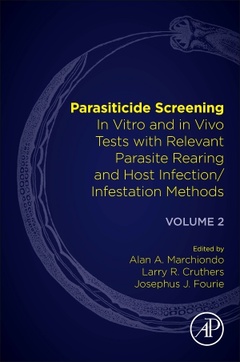Description
Parasiticide Screening
Volume 2: In Vitro and In Vivo Tests with Relevant Parasite Rearing and Host Infection/Infestation Methods
Authors: Marchiondo Alan A., Cruthers Larry R., Fourie Josephus J.
Language: English
Subjects for Parasiticide Screening:
146,54 €
Disponible chez l'éditeur (délai d'approvisionnement : 14 jours).
Add to cart722 p. · 15x22.8 cm · Broché
Résumé
/li>Sommaire
/li>Lectorat
/li>Biographie
/li>Commentaire
/li>
Parasiticide Discovery: In Vitro and In Vivo Tests with Relevant Parasite Rearing and Host Infection/Infestation Methods, Volume Two presents valuable screening methods that have led to the discovery of the majority of parasiticides commercialized in the animal health industry. As much of the knowledge of parasiticide discovery methods is being lost in the animal health industry as seasoned parasitologists retire, this book serves to preserve valuable methods that have led to the discovery of the majority of parasiticides commercialized in animal health, also giving insights into the in vitro and in vivo methods used to identify the parasiticide activity of compounds.
1. In Vitro Parasiticide Discovery Screening Methods by Parasite Species2. In vivo Parasiticide Discovery Screening Methods by Host Species3. Statistical Considerations of Parasiticide Screening Methods and Confirmation Trials
Parasitologists and entomologists: graduate students, faculty, teachers, researchers, Veterinarians, graduate students, faculty, teachers, researchers, clinicians. Pharmacologists, Medicinal Chemists, Toxicologists, Molecular Biologists, Cell Biologists, Public Health Workers, Government Agencies
• AAVP Vice-President 2010-2011
• AAVP President-Elect & Program Chair, 2011-2012
• AAVP Secretary/Treasurer 2004-2010
• AAVP Program Administrator and Executive Secretary, 2014-Present
• Editorial Board Member - Veterinary Parasitology, 1988-Present
• 30-year career in the animal health industry
• 50+ Publication in Peer reviewed Scientific Journals
• Edmonds. M.D., Vatta, A.F., Marchiondo, A.A., Vanimisetti, H.B., Edmonds, J.D. 2018. Concurrent treatment with a macrocyclic lactone and benzimidazoles provides season long performance advantages in grazing cattle harboring macrocyclic lactone resistant nematodes. Vet Parasitol 252:157-162.
• Ballweber, L.R., Beugnet, F., Marchiondo, A.A., Payne, P.A. 2014. American Association of Veterinary Parasitologists’ review of veterinary fecal flotation methods and factors influencing their accuracy and use – Is there really one best technique? Vet Parasitol 204:73-80.
• Riviere, J.E., Brooks, J.D., Collard, W.T., Deng, J., de Rose, G., Mahabir, S.P., Merritt, D.A., Marchiondo, A.A. 2014. Prediction of formulation effects on dermal absorption of topically applied ectoparasiticides dosed in vitro on canine and porcine skin using a mixture-adjusted quantitative structure permeability relationship. J Vet Pharm Therap 37 (5):435-444.
• Marchiondo, A.A., Holdsworth, P.A., Fourie, L.J., Rugg, D., Hellman, K., Synder, D.E., Dryden, M.W. 2013. World Association for the Advancement of Veterinary Parasitology: W.A.A.V.P. second edition: Guidelines for evaluating the efficacy of parasiticides for the treatment, prevention and control of flea and tick infestations on dogs and cats. Vet Parasitol 194:84-97.
• Campbell, W.C., Conder G.A, Marchiondo A.A. 2009. Future of the animal health industry at a time of food crisis. Vet Parasitol 163 (3): 188-195.
• Marchiondo, A.A., Holdsworth, P.A., Green, P., Blagburn, B.L., Jacob
- Addresses current issues of resistance, along with combination uses for resistant parasites
- Presents useful, authoritative information (chemical, pharmaceutical, clinical, etc.) for the pyrantel family of compounds
- Includes a discussion on screening methods in combination therapies
- Provides cutting-edge material for an evolving area of scientific discussion
- Includes in vitro and in vivo screens and parasite maintenance and culture methods




